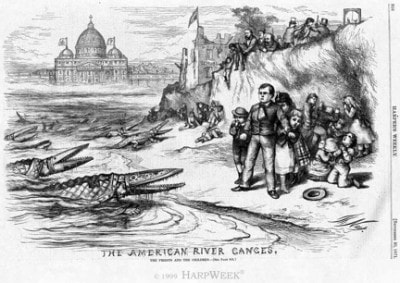AuthorBy Joan Brodsky Schur, Village Community School The vilification of the “religious other” is nothing new in America and in fact has a long history. This lesson is designed to shed perspective on the sources and nature of today’s anti-Islam rhetoric by looking back to a period of virulent anti-Catholicism in United States history. It rose to prominence in the 1850s as a response to the influx of huge numbers of Irish immigrants and was spearheaded by the No Nothing Party. The party’s anti-Catholic and anti-immigrant stance can be compared to other anti-Semitic and anti-Islamic movements in that they all share the belief that –– through religion –– foreign powers are trying by stealth to take over America. All aspects of the “other” religion are seen as categorically inimical to American democracy, by the very nature of the religion itself. To start the lesson, distribute the document below without giving students or eliciting from them any historical background. Simply tell students that the document was written about some religion at some point in time in America. Explain that in this version of the document the name of the religion is replaced by an “X.” (To avoid confusion the words Republic and Republican have been changed in various places to read nation, democracy and form of government.) Directions The influx of greater and greater numbers of immigrants who practiced Religion X has caused great prejudice at various times in American history. Read the following primary source document regarding Religion X and then answer the following questions as your teacher instructs you to. Bound to Serve Their Religion Before The Country Questions to be answered in pairs or small groups
Debriefing Questions for Class Discussion:After you disclose the actual name of Religion X (Catholicism) and the date of the primary source document (1854) pose the following questions:
According to R. Scott Appleby and John T. McGreevy (New York Review of Books, September 30, 2010) the imam of the proposed Islamic center in downtown Manhattan, Feisal Abdul Rauf, “claims, correctly, that the vast majority of the nation’s Muslims abhor al-Qaeda.” Why then are there Americans who fear Muslim Americans in general? What role does anti-Islamic rhetoric play? How much do you think Americans know about the religion Muslims practice, the second largest world religion? How would you feel if you were a Muslim in America today (or how do you feel if you are one)? For a very good short comparison of religious intolerance in America towards Catholics and Muslims, see “Catholics, Muslims, and the Mosque” by R. Scott Appleby and John T. McGreevy (New York Review of Books, September 30, 2010 p.48). In their article, the authors discuss the ways in which Catholicism as practiced in America has evolved over time as a result of Catholics’ experience in the United States: “the American acceptance and encouragement of Catholic parishes and schools, once seen as threatening, reshaped an international religious institution,” they write. Extension Activities Some students will grasp the power of imagery more readily than words. Therefore distribute the anti-Catholic cartoon from 1875 entitled “The American River Ganges.” Here Thomas Nast depicts the Roman Catholic clergy as crocodiles invading the shores of America to devour America’s students. Catholicism is seen as a threat to the separation of church and state as the public school sends out a signal of distress. To help students deconstruct the meaning of this cartoon for themselves, distribute the Cartoon Analysis Worksheet from the National Archives http://www.archives.gov/education/lessons/worksheets/cartoon.html. For more information about the cartoon go to HarpWeek http://www.harpweek.com/09cartoon/BrowseByDateCartoon.asp?Month=May&Date=8. How can we learn to identify Islamophobia? In Great Britain the Runnymede Trust, an independent think tank, generated this definition in 1997 which has been widely accepted in Europe. It can be accessed at Islamophobia Watch http://www.islamophobia-watch.com/ 1) Islam is seen as a monolithic bloc, static and unresponsive to change. Distribute this document to students. Ask students which of these definitions could be applied to the anti-Catholic primary sources used in this lesson if you substituted the word Catholicism for Islam.
Now ask students to apply the Runnymede definition to various anti-Islamic comments made by commentators, much of it in response to the proposed Islamic center in lower Manhattan. Some of the biased and untruthful statements prevalent in the media can be found online at Media Watch http://www.mediawatch.com/, the Southern Poverty Law Center http://www.splcenter.org/, and Islamophobia Watch http://www.islamophobia-watch.com/. For information about Islam and how citizens are reacting to the rhetoric of hate, go to http://www.groundzerodialogue.org/
0 Comments
Your comment will be posted after it is approved.
Leave a Reply. |
What We Do |
Middle East Book Award |
© COPYRIGHT 2018. ALL RIGHTS RESERVED.
|

 RSS Feed
RSS Feed
